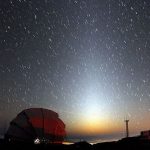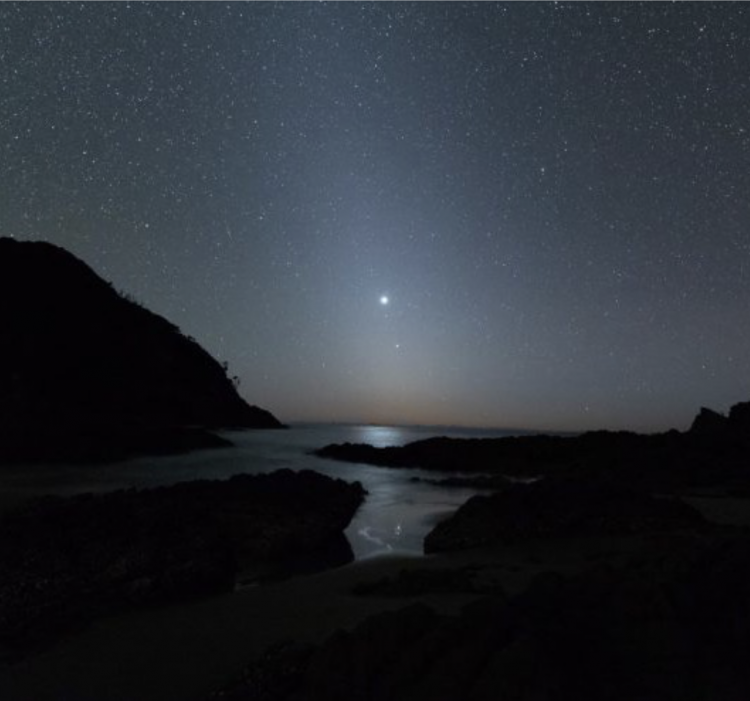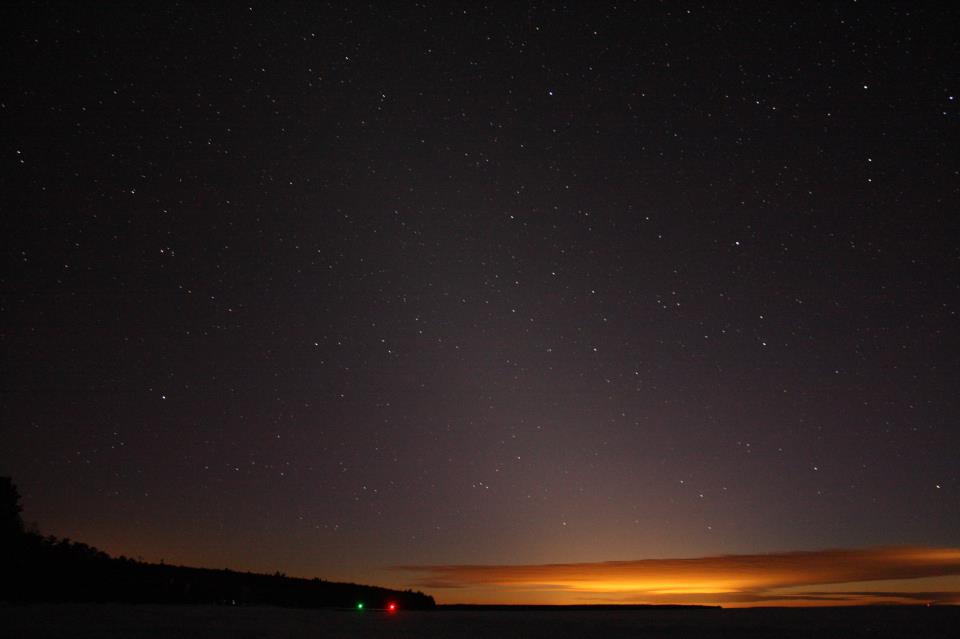
View the image above full-sized at EarthSky Community Photos. | Caroline Haldeman captured this image from Flagstaff, Arizona on January 11, 2021. It’s the hazy pyramid of the zodiacal light, part of a video she made, which you can see here. Thanks, Caroline!
Full moon for February 2021 comes on February 27. Afterwards, the moon will be waning and gone from the early evening sky. Moonless evenings in late February, March and early April present the best time of year to see the zodiacal light in the Northern Hemisphere. Meanwhile, from the Southern Hemisphere, the zodiacal light is best seen before dawn at this time of year. The light appears when all traces of twilight have left the evening twilight, or before dawn’s light begins.
For us Northern Hemisphere dwellers, the zodiacal light will look like a hazy pyramid of light in the west after true darkness falls, on moonless evenings in the coming months.
This light can be noticeable and easy to see from latitudes like those in the southern U.S. I’ve seen it many times from the latitude of southern Texas, sometimes while driving a lonely highway far from city lights, up to an hour or so after evening dusk leaves the sky.
In that case, the zodiacal light can resemble the lights of a city or town just over the horizon.
Skywatchers in the northern U.S. or Canada sometimes say wistfully that they’ve never seen the zodiacal light. On the other hand, sometimes the camera will pick up faint objects that the eye can’t see. And we’ve had reports of the zodiacal light visible to the eye by those at northerly latitudes.

View at EarthSky Community Photos. | This zodiacal light photo comes from 2018, from Great Barrier Island near New Zealand. The faint cone of light is the zodiacal light, seen before dawn. Notice the bright object in its midst. That’s Venus. Another pinpoint of light below Venus is Mercury. We’re showing you this photo now because – if you’re in the Northern Hemisphere in 2020, watching for the zodiacal light in the evening – you might see Venus, and maybe even Mercury too, in its midst! Photo by Carol Comer. Thank you, Carol!
You definitely do need a dark sky location to see the zodiacal light, someplace where city lights aren’t obscuring the natural lights in the sky. Remember, the zodiacal light is a pyramid-shaped glow in the west after dark. It’s even “milkier” in appearance than the starlit trail of the summer Milky Way.
The light is most visible after dusk at this time of year because (as seen from the Northern Hemisphere) the ecliptic – or path of the sun, moon, and planets – stands nearly straight up with respect to the horizon after the sun sets in February and March.
The zodiacal light can be seen for up to an hour after dusk. Unlike twilight dusk, though, there’s no rosy color to the zodiacal light. The reddish color of the skies at dusk and dawn are caused by Earth’s atmosphere, and the zodiacal light originates far outside our atmosphere.
When you see the zodiacal light, you are looking edgewise into the plane of our own solar system. The zodiacal light is sunlight reflecting off dust particles that move in the same plane as Earth and the other planets orbiting our sun.
Remember, if you live in the Southern Hemisphere, your late winter/early spring months (August, September, October) are the best time for you to see the zodiacal light in the evening. Right now (February, March, April), you should be looking for the zodiacal light before dawn.

View larger. | EarthSky Facebook friend Jim Peacock is in northern Wisconsin, which is farther to the north on Earth’s globe than usual for easy viewing of the light. Yet he caught this zodiacal light in February 2013. He said: “Yes, it was very visible to the eye … it reached high above the horizon. Was so cool to see over Lake Superior.” You can also see the Circlet of Pisces to the lower right of center, and the Y-shaped Water Jar of the constellation Aquarius to the lower right of the Circlet, just above the sunlit cloud.
Bottom line: From the Northern Hemisphere, look for the elusive zodiacal light, a hazy pyramid of light extending up from the sunset point. Southern Hemisphere? Look before dawn!
from EarthSky https://ift.tt/2SOajLK

View the image above full-sized at EarthSky Community Photos. | Caroline Haldeman captured this image from Flagstaff, Arizona on January 11, 2021. It’s the hazy pyramid of the zodiacal light, part of a video she made, which you can see here. Thanks, Caroline!
Full moon for February 2021 comes on February 27. Afterwards, the moon will be waning and gone from the early evening sky. Moonless evenings in late February, March and early April present the best time of year to see the zodiacal light in the Northern Hemisphere. Meanwhile, from the Southern Hemisphere, the zodiacal light is best seen before dawn at this time of year. The light appears when all traces of twilight have left the evening twilight, or before dawn’s light begins.
For us Northern Hemisphere dwellers, the zodiacal light will look like a hazy pyramid of light in the west after true darkness falls, on moonless evenings in the coming months.
This light can be noticeable and easy to see from latitudes like those in the southern U.S. I’ve seen it many times from the latitude of southern Texas, sometimes while driving a lonely highway far from city lights, up to an hour or so after evening dusk leaves the sky.
In that case, the zodiacal light can resemble the lights of a city or town just over the horizon.
Skywatchers in the northern U.S. or Canada sometimes say wistfully that they’ve never seen the zodiacal light. On the other hand, sometimes the camera will pick up faint objects that the eye can’t see. And we’ve had reports of the zodiacal light visible to the eye by those at northerly latitudes.

View at EarthSky Community Photos. | This zodiacal light photo comes from 2018, from Great Barrier Island near New Zealand. The faint cone of light is the zodiacal light, seen before dawn. Notice the bright object in its midst. That’s Venus. Another pinpoint of light below Venus is Mercury. We’re showing you this photo now because – if you’re in the Northern Hemisphere in 2020, watching for the zodiacal light in the evening – you might see Venus, and maybe even Mercury too, in its midst! Photo by Carol Comer. Thank you, Carol!
You definitely do need a dark sky location to see the zodiacal light, someplace where city lights aren’t obscuring the natural lights in the sky. Remember, the zodiacal light is a pyramid-shaped glow in the west after dark. It’s even “milkier” in appearance than the starlit trail of the summer Milky Way.
The light is most visible after dusk at this time of year because (as seen from the Northern Hemisphere) the ecliptic – or path of the sun, moon, and planets – stands nearly straight up with respect to the horizon after the sun sets in February and March.
The zodiacal light can be seen for up to an hour after dusk. Unlike twilight dusk, though, there’s no rosy color to the zodiacal light. The reddish color of the skies at dusk and dawn are caused by Earth’s atmosphere, and the zodiacal light originates far outside our atmosphere.
When you see the zodiacal light, you are looking edgewise into the plane of our own solar system. The zodiacal light is sunlight reflecting off dust particles that move in the same plane as Earth and the other planets orbiting our sun.
Remember, if you live in the Southern Hemisphere, your late winter/early spring months (August, September, October) are the best time for you to see the zodiacal light in the evening. Right now (February, March, April), you should be looking for the zodiacal light before dawn.

View larger. | EarthSky Facebook friend Jim Peacock is in northern Wisconsin, which is farther to the north on Earth’s globe than usual for easy viewing of the light. Yet he caught this zodiacal light in February 2013. He said: “Yes, it was very visible to the eye … it reached high above the horizon. Was so cool to see over Lake Superior.” You can also see the Circlet of Pisces to the lower right of center, and the Y-shaped Water Jar of the constellation Aquarius to the lower right of the Circlet, just above the sunlit cloud.
Bottom line: From the Northern Hemisphere, look for the elusive zodiacal light, a hazy pyramid of light extending up from the sunset point. Southern Hemisphere? Look before dawn!
from EarthSky https://ift.tt/2SOajLK

Aucun commentaire:
Enregistrer un commentaire